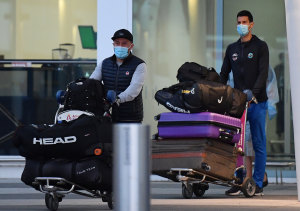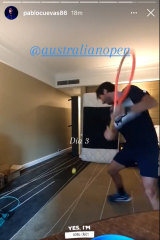Numb to COVID’s carnage, tennis stars learning fast about Australia’s foreign fight
The trip to Australia has always been the longest of the tennis season for most of the world's players, but never before has the destination felt more distant or foreign.
Players stepping off the plane in Melbourne enter a city where citizens can walk freely without masks, where the daily death count has never been broken up by commas. Melbourne has rallied together to rid itself of the coronavirus pandemic which has plagued most of the world, weathering a storm to return to life almost as normal.
Novak Djokovic arrives at Adelaide Airport in January.Credit:Mark Brake/ Getty Images
What’s unclear is how many of the players appreciate just how different life in Australia is now before boarding their charter flights.
Tennis players are uniformly well-travelled, but few could be called worldly. They go from city to city, country to country, continent to continent, but rarely see sights beyond the locker room, the courts, the hotel, a restaurant near the hotel, and the airport.
They rarely gain a meaningful appreciation for a place or its people beyond the surface. All they know is what little they see on their narrow path around the globe; maybe a handful of the more curious ones will occasionally click a news article link when it pops onto their Twitter feed.
The players won’t have known just how strict the lockdowns were that Melbourne experienced for months. They won’t have known about the thousands of Australians still stranded overseas, waiting for an opportunity to come home.
What they will have realised immediately is that this grand slam event, the third since the pandemic began, feels nothing like last year’s US Open or French Open.
Tennis players about to train while in quarantine at View Melbourne hotel.Credit:JOE ARMAO
In New York, players mixed in common areas of the hotels and tournament grounds soon after arriving, socialising around amenities the tournament had installed like ping-pong tables and karaoke machines. In Paris, play continued on in uninterrupted obliviousness even as the city’s infection rates spiked, forcing cafes and other businesses to close.
Pablo Cuevas practises his backhand in hotel quarantine ahead of the Australian Open. Credit:Pablo Cuevas, Instagram
In Melbourne, the players were swiftly locked away alone in a hotel room. Matters quickly got worse: after positive coronavirus tests popped up from several different charter flights, more than 72 players had their promised practice privileges revoked during the 14-day quarantine.
It was clear many players had not adequately understood the possibility for that to happen, a failure of communication for which mutual blame must fall upon them and Tennis Australia, and its chief executive Craig Tiley, who so often has painted an impossibly rosy picture for his tournament’s outlook. Maybe it was never fair to promise players that things could go smoothly.
The cold, harsh reality of their airconditioned captivity left many players embittered. Roberto Bautista Agut, a quarter-finalist at the Open two years ago, likened the quarantine to being “in the jail” (albeit "with wifi"). He railed against what he saw as government incompetence at facilitating tennis preparations.
"These people have no idea about tennis, about practice courts; they have no idea about anything," Bautista Agut told Israeli television station Sport5. "It's a complete disaster because of that."
Novak Djokovic, the eight-time Australian Open champion who has emerged as a leading – if persistently unpersuasive – voice for the players, came up with a list of changes he wanted to see, including shortened quarantine times and the ability for players to stay in private houses with attached tennis courts.
Kyrgios, who has made the shocking transition over the past year from being told to stay quiet to being cheered as speaking up for the vox populi, predictably called Djokovic “a tool”. He, like nearly all Australians, thought Djokovic and the rest had a lot of learning to do.
With more than a week left in their isolation chambers, hopefully there’s time for that learning to take place. Last year, players showed a great deal of empathy and charity to Australia as the country was charred by ravaging bushfires that destroyed homes and wildlife. The fires were easier to understand, maybe: players could see the flames, breathe in the smoke. This year, they’ll have to learn what it’s like to sacrifice and stay inside by doing just that: sacrificing and staying inside.
I'm writing this from Washington DC, the capital of a country where yesterday there were 1730 coronavirus deaths reported. That's an utterly horrifying number, but it represents a huge drop from each of the previous five days, on which the daily death count in America had been well over 3000. When you learn that 1730 people died and see it as an improvement, you're hopelessly numb to death.
That sort of numbness certainly contributes to the lack of sensitivity for which many Australians have criticised the arriving players: when you're used to life in a country that has been resigned to denial of this disease and can't fathom why its continued worst efforts still aren't enough to defeat it, competence is foreign.
Ben Rothenberg is a freelance tennis writer for the New York Times.
Sport newsletter
Sports, results and expert commentary delivered straight to your inbox. Sign up to the Herald‘s weekday newsletter here and The Age‘s weekly newsletter here.
Most Viewed in Sport
Source: Read Full Article



